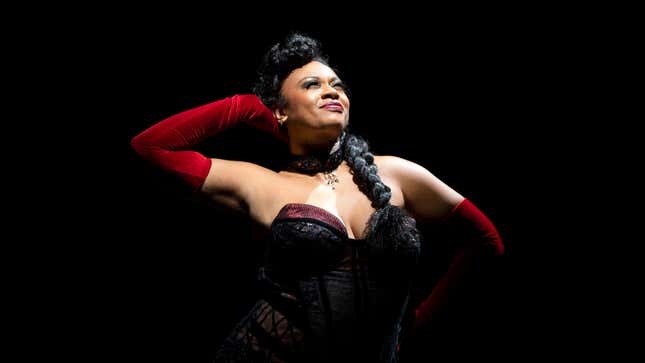
Off stage, actor Jacqueline B. Arnold is an Angeleno-turned-New Yorker, artist, wife, and side-hustler. (During the pandemic, she and her partner Shannon Arnold began a business making cannabis-infused topicals under the name The Kitchen Chemist.)
But six nights a week, she synthesizes these elements and morphs into a different persona all together — decked out in red feathers and turn-of-the-century corsetry as the sexy, street-smart La Chocolat, one of the four lead showgirls who anchor the live production of Moulin Rouge! The Musical. ICYMI, this is Baz Luhrmann’s revolutionary film Moulin Rouge! brought to life on Broadway, with a soundtrack that blends favorites from the movie and some energetic new additions.
Having been in the Tony Award-winning production for six years (since its very first curtain call), Arnold originated the role of La Chocolat and is one of five performers remaining from the show’s inaugural cast. While you might not recognize her name from the 2001 movie, you’ll likely understand La Chocolat’s roots — that is if the timeless banger Lady Marmalade is tattooed into your brain.
Along with the other three Lady Ms, Arnold opens the show with rhythmic, slithering snaps, making a sultry metronome for its iconic first number. “My family is from New Orleans, and we’re talking about Creole women, which is a huge part of my being. I feel so indelibly printed on this role because of that song.”
At 49, Arnold has been on stage for 38 years of her life, first singing and dancing for an audience at 8 in her school’s production of The Wiz, then attending an arts magnet junior high in Hollywood. “Everything was movie musicals rather than stage productions, and performing was my thing, but it’s not like we had a Broadway to aspire to.”
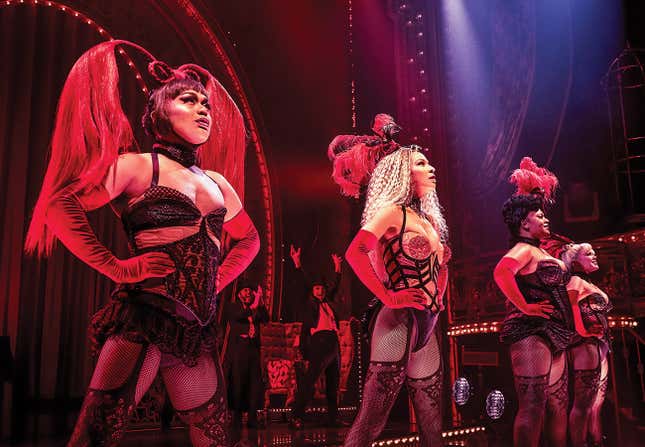
It wasn’t until she was in her early twenties—when her class at Antelope Valley College in Lancaster, California, attended a touring production of Ragtime—that she could envision musical theater as a career for herself. “In that show, you have the Jewish people, the Anglo-Saxon people, the Black people. I was both floored and inspired to see myself represented on that stage, and it really made me realize that I could make a living doing this.”
Singularly focused on making a career out of her trifecta of talents, she landed her first role in Oklahoma at 23, next Hair and then The Goodbye Girl, which taught her about her capacity to lead a show. “The lead is a single parent to a 12-year-old daughter. She doesn’t know where her next thing is gonna come from, and I thought: ‘Growing up as the only daughter of a single parent, I know this life.’ The proverbial light switch went off, and I was on my way.”
Today, the Broadway legend is an inspiration to women who refuse to let their queerness, Blackness, or size stand in the way of showing up as their authentic selves — whether their stage is real or metaphorical. The Root caught up with Arnold to go behind the scenes of the show and how she’s reshaping the mold for an empowered Black woman in showbiz.
As the originator of a role that allows so many women to see themselves represented, what would you tell young Jackie if you could say anything to her?
Jacqueline B. Arnold: If I could talk to 13-year-old Jackie, I would tell her ‘Girl, your instincts were right. Follow them. You love being on stage. It’s where you feel like the truest version of yourself. It’ll all work out for you.’
As for 23-year-old Jackie, I’m impressed with her for making the choice to pursue this career and respecting the 13-year-old girl inside of her. After all, at 23 you really know nothing, right? Yet at that age, I still had the confidence to know that I had to be true to myself and put a little of ‘me’ in whatever I wanted to do if I was going to succeed.
At 13 or even 33, that is such a major skill to know yourself to that degree and refuse to let anything stand in your way.
Jacqueline B. Arnold: Well, little Jackie didn’t want to be a star like Mariah; she just wanted to perform. As a young woman, about ages 15-17, I tried to model, but you know, I liked food!
I was also in some singing girl groups, because vocals came easily to me. However, landing jobs in that industry involved molding myself to these unrealistic physical standards. Keep in mind that I’m 5’10”, I was 5’9” by the time I was 15 and curvy.
I was also growing up in Hollywood, which was steeped in the modeling industry, and all about sexualizing young girls, and my Mom was not having it. Thankfully, she always said ‘We’re gonna keep her at the age she’s at’’ and refused to let the business steal my kid years, which makes a major difference in a scene that pressures you to grow up so quickly.
So she made sure to monitor me, not with a super tight grip, but always to keep me in a place where the adults respected however I showed up in the moment. And that translated to me always respecting who I really am.
What was the audition process like for the role of La Chocolat?
Jacqueline B. Arnold: My process was a little unconventional. A friend of mine was one of Sonya Tayeh’s dancers [the Tony Award-winning choreographer of Moulin Rouge! The Musical], and Sonia was assembling a presentation for her audition for the show. It was a prototype of the opening number “Lady Marmalade”; the stage version is about 20 minutes long and anchored by the Lady Ms.
She was looking for anyone who could sing the song in any capacity, and my friend chimed in and said, ‘I actually know someone who’s been singing that song her whole life, and she can do it as a solo if necessary.’
When we got together to rehearse, it was basically me and four other women, and everything snowballed into this new entity. Movement is Sonia’s specialty rather than music, so I offered to help her assemble the vocal, and I ended up becoming sort of the de-facto vocal director for Sonia’s audition.
Alex Timbers [the show’s Tony Award-winning director] and Justin Levine [the show’s Tony Award-winning music supervisor] were there on audition day, along with a couple producers, all the bigwigs, so we were performing for our lives.
I honestly thought it was just gonna be a one-off, not an audition … About two to three years ago, Alex Timbers told me: ‘From that day on, you were the first Lady M cast in my mind.’ After that, I only had like two callbacks, and since then, I’ve been in it. It’s been six years with this show.
The Lady Ms are so integral in the show, a turn-of-the-century take on an ancient Greek chorus, like co-masters of ceremony to Harry Zidler, the owner and emcee of the Moulin Rouge nightclub. I’d love to hear more about La Chocolat’s role in the Lady Ms and what elements of your own personality you lend to her.
Jacqueline B. Arnold: As actors, we make up our backstories. The four Lady Ms [played by Sophie Carmen-Jones, Tasia Jungbauer, and David Merino], Harry Zidler [played by Eric Anderson], and Toulouse Lautrec [played by André Ward] are the six real people who existed beyond the show.
I recently visited the real Moulin Rouge in Paris and found pictures of the woman who was likely the inspiration for La Chocolat. She seemed to be from Northern Africa and looked like she may have been from Ethiopia. From those clues, I could write the rest of her story. I decided she was the eldest of the girls and that she probably had a family back in Africa, moved to Paris to create a better life, and sent as much money home as she could to take care of her entire family.
She’s also very close with Zidler and is really the only one he trusts with money or privileged information of what’s really going on in the club [i.e. the fact that the Moulin Rouge has fallen on hard times, and its survival depends on the patronage of The Duke] so I think of her as second in command. If he has to go, she would be able to run the show.
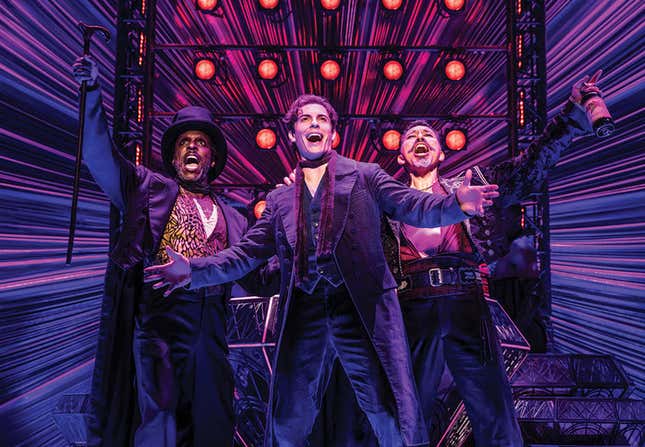
There’s also this idea that any of the Lady Ms may have been the Sparkling Diamond [Satine in the show, currently played by popstar Jojo Levesque] at any point in the past. Once you retire from being that leading lady, you essentially become a Lady M.
This was the case with Nini, though the two other Lady Ms, Arabia and Babydoll, weren’t. Babydoll is the show’s drag queen, and in Paris 1899, he was treated like a creature on the streets and didn’t have a home. Satine brought him in.
I also pulled from my own experiences, in terms of understanding what it would be like to be an African woman in 1899 Paris. Knowing historically all of us melanated people had more opportunities in Europe than we did in the Americas, I used that bravado to embody the character in this self-confident way. Like, I have zero qualms about who I am within the confines of my Moulin Rouge life.
Now, does La Chocolat go home at night and maybe she has pointless sex with someone? Probably. Does she drink a lot? Yes, I think she’s an alcoholic. She misses her family so much, and even if she’s got all this bravado and power, her woes of missing her loved ones get to her in those private moments.
She’s also sort of a madam in it all. She always has money in her wallet (aka her bra), and any of the courtiers who come to visit have to pay her the cash before they get to interact with any of the women.
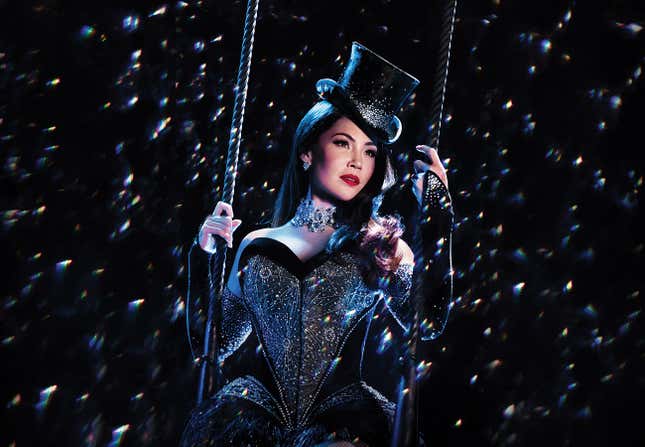
Having seen the movie, I would assume that would be a Zidler thing.
Jacqueline B. Arnold: Right, but he’s so busy schmoozing and dealing with the guys, making sure everything is running that he can’t hold the purse. So she does, cause she’s the most trusted.
Do you have a favorite number in the show to perform and why?
Jacqueline B. Arnold: Most people assume it would be the opening number, and don’t get me wrong, I love it. But when it comes to that immersive feeling, where you feel like you’re performing in a music video, It would be Satine’s entrance, “Diamonds.” The Lady Ms are this singing, dancing girl group, and you get to channel your most badass self.
The show took a major hiatus during the pandemic, as all of Broadway did, and surely the show has evolved since then. Today, in May 2023, what can theatergoers look forward to when they go to see the show?
Jacqueline B. Arnold: The general idea of the show still holds true, and we always wanted it to feel very immersive and interactive, like you’ve literally walked into the Moulin Rouge in Paris.
Even before the show begins, there’s a whole scene painted for you, and you’re immediately sucked into that world. We have these opulent drapes, men and women dancing in cages, the giant lights on the Moulin Rouge. Instead of an orchestra pit, we have café-style seating and a passerelle, so the players are so close they can literally touch you. I grab their heads and tousle up their hair.
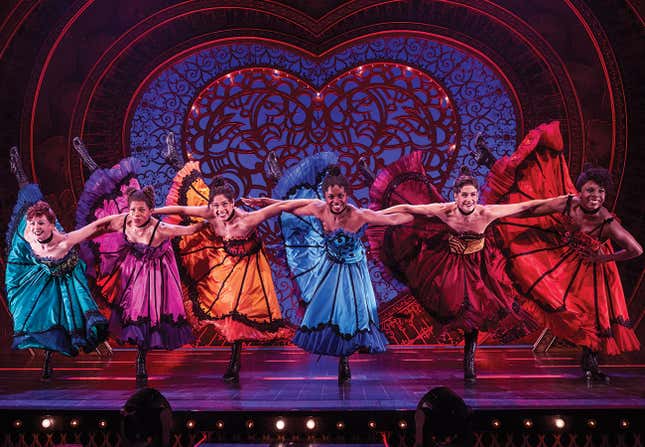
Once the downbeat of “Lady Marmalade” hits, there is not a single person who doesn’t know this version of the song. When you hear the snaps, you get this raucous arena kinda roar. You might be in party mode, chill and watch mode, or you might be a voyeur. There’s a sense of heightened sexuality, community, and family. There’s feminism and standing up for yourself in a major way.
You recently posted on social media, reflecting about your experience in showbiz and the way it imposes body standards on women, especially Black, queer women of size. What spurred this public statement?
Jacqueline B. Arnold: For me, loving the body I’m in has been a lifelong battle. Like I said, I went to school in Hollywood and was a dancer in my teen years. With that comes secretive eating disorders.

I had seen and tried a lot of things I shouldn’t have at age 13. My self-diagnosis was definitely somewhat bulimic between then and like 16-17, all in pursuit of fitting into this mold of what beauty was supposed to look like. I was 5’9” wearing a size five, and I was asked to lose weight.
I think part of what has kept me in this role of La Chocolat for so long is that I just get to exist as myself. They didn’t hire me because I was the plus-size girl or the regular-size girl. They hired my talents. It didn’t matter to Alex. He didn’t even see my curves, any of it. But then on the positive side, my size lends to the realism in the show. Many of these characters were real people, and they didn’t look like what we think a dancer looks like now.
On that trip to Paris I mentioned, I saw pictures of the dancers, and they weren’t bone-skinny women. They didn’t even have dance technique! Most of their feet were turned in. All the shapes and sizes were represented. So for me, I take this stance on body positivity, because what my body looks like has nothing to do with my dancing ability, my vocal ability, my acting ability, my ability to tell the story. Literally nothing.
I get all these women who write to me on social media or who greet me at the stage door, who are just so grateful to be represented in size—not even racially. It makes them feel like they can go to a dance class and not feel crazy. I still have sex appeal, sexuality, and sensuality, even with rolls or curves.
This is who you are, and somebody is gonna love you because that’s the bottom line. We all just want to be appealing to whoever we like. But you’re never gonna be that unless you enjoy yourself.
Inclusivity is finally an open conversation in showbiz. Even in a creative realm like Broadway, these conversations are long overdue. How have you experienced the discourse changing around racial, queer, and size inclusivity in musical theater?
Jacqueline B. Arnold: It’s crazy that there is discourse at all, because all my musical theater friends have been queer and creative and off beat forever, which has always made the space feel like home. Being a woman, I’ve always considered myself to be somewhat bisexual, and then I realized that I just like who I like. Then it evolved further, to where I acknowledged that if I married someone, it would probably be a woman.
Granted, it’s odd that we actually have to have these conversations in an industry built off of misfits. Like most musical theater people fall into that category of being different—in middle school, high school, and beyond. When we make it into the adult, paycheck-cashing world of musical theater, we realize the same viruses have infiltrated our safe space.
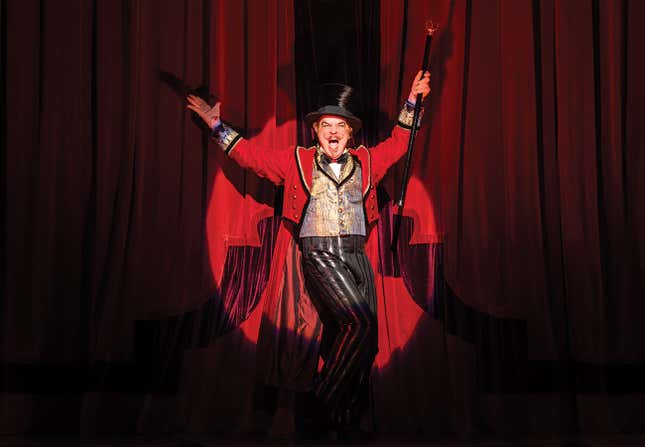
Of course, when it comes to racial injustice, George Floyd opened everybody’s eyes. And it wasn’t like that wasn’t happening before 2020, but we were all sitting down. This opened the door for Broadway as an entity, as a business, to get called out for keeping things in a very tight template.
In the cookie-cutter template of the Broadway show, we’ve always had the ingénue who was never any taller than 5’5”, and if she was of some sort of ethnicity, she still had to look like she was white. She had to be a soprano, and god forbid she was ever bigger than her leading man.
The friend, or supporting character, could be all sorts of things—racially, of size. On Broadway, you’d always see at least one couple in the ensemble who would visually be people of color, which checked a box. But then all of a sudden, this pandemic happened, and people said ‘We’re no longer standing for simply checking that box. Why aren’t we telling diverse stories? Why aren’t we not just telling Black, Latino, Asian stories, but why aren’t we telling stories of real people in a size situation? What about queer people?’
Right now, representing trans people appropriately on the Broadway stage is at the forefront of things. I think it’s way overdue, because going back, we are a community of queer people—in whatever way you want to interpret that word. We’re just now acknowledging trans people? That’s a problem.
And sure, it can sometimes feel like a bone is being thrown, because most of the people holding the purse in the business are of normative identities. You wonder if minds are actually changing, or if people are just prioritizing inclusivity because it’s the hot ticket. Inclusivity just needs to be consistent, and we have to keep fighting and pushing for more … People have to continue to care and resist the urge to get lazy about it.
The mercurial nature of what’s profitable often ends up at odds with the messages in powerful art. Even when those messages are bankable, they definitely run the risk of being reduced to a trend, so much of this depends on audiences continuing to demand them.
But as in the show, those Bohemian ideals of truth, beauty, freedom, and love can be a guiding light. Do you find yourself returning to these principles in your Moulin Rouge! The Musical life?
Jacqueline B. Arnold: Listen, it’s Groundhog Day every day in musical theater. My wife always tells me—’I don’t know how you do the exact same thing every day.’ But if you’re really living in your truth, each performance will feel different. Some days, I’m crazy hyped—hitting everything really hard, with lots of power—then on others, I feel really low-key, chill—so I’m more internal, more smoky. Every day on stage, I return to the truth of how I’m feeling about the day, and that’s the performance the audience will see.
Otherwise, that’s cookiecutter, and who wants to go to the theater for that?
My representation and the gentleman who plays Babydoll give a huge scope of what is considered beauty in our world. Currently, Jojo is playing Satine, but her standby is this woman named Oyoyo Joi, a very brown-skinned Black woman. When she’s on, you see the audience react with appreciation and awe reacting to a gorgeous, melanated woman.
Freedom goes along with truth; you have this freedom as a performer to be who you want to be on this stage. That’s kinda fierce. Imagine if you had that in your life every day, that you get to go and be whoever you want on stage.
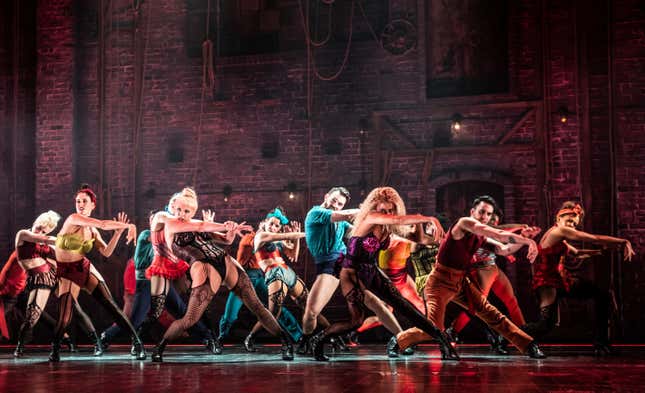
As for love, I love my cast. I told a bunch of them yesterday that I have not laughed this much at work in so many years. They’re so silly and so much fun, and there’s all different ages, from people in their sixties to like 23, and I’m somewhere in the middle. I just enjoy everyone so much, and they make it a pleasure to do this job.
Moulin Rouge! The Musical — the winner of 10 Tony Awards® including Best Musical—is now playing on Broadway. Get your tickets today!
This post is a sponsored collaboration between Moulin Rouge! The Musical and G/O Media Studios.

